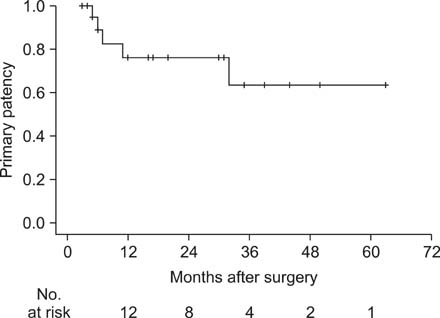Ann Surg Treat Res.
2014 Feb;86(2):91-94. 10.4174/astr.2014.86.2.91.
Long-term outcome of crossover femoro-femoro-popliteal bypass using side-to-side anastomosis in ilio-femoral occlusive disease
- Affiliations
-
- 1Division of Vascular/Endovascular Surgery, Department of Surgery, Daegu Catholic University Medical Center, Catholic University of Daegu School of Medicine, Daegu, Korea. wsyun@me.com
- KMID: 1908503
- DOI: http://doi.org/10.4174/astr.2014.86.2.91
Abstract
- PURPOSE
During crossover femoro-femoro-popliteal sequential bypass (CFFPB) surgery in ilio-femoral occlusive disease, proximal anastomosis of the femoro-popliteal bypass is usually performed distal to the distal anastomosis of the crossover femoro-femoral bypass. If not, it is done with a piggyback configuration. Another method is a side-to-side anastomosis. Its benefit is that this is the only anastomosis made. And it is less bulky compared with the piggyback configuration. This study was aimed to investigate the long-term outcome of CFFPB using side-to-side anastomosis.
METHODS
From Sep 2006 to Aug 2012, 21 patients who underwent CFFPB using side-to-side anastomosis were enrolled. Externally supported polytetrafluoroethylene graft was used as a conduit in all patients. Patient demographic data and procedure details were investigated. Primary graft patency was calculated using the Kaplan-Meier method.
RESULTS
The mean age of patients was 79 years (range, 62-81 years) and males were 17 (81%). Fifteen patients (71%) had critical limb ischemia. Inflow arteries comprised of 16 common femoral artery (CFA), 4 superficial femoral artery (SFA), and 1 deep femoral artery (DFA). Side-to-side anastomosis was performed on the CFA in 11, SFA in 2, and DFA in 8 patients. During the mean follow-up period of 21 months (1-60 months), 8 patients died. The 1-, 3-, and 5-year primary patency rates were 76%, 63%, and 63%.
CONCLUSION
Long-term patency of CFFPB using side-to-side anastomosis was acceptable. It can be one of the treatment options for patients with ilio-femoral occlusive disease.
Keyword
MeSH Terms
Figure
Reference
-
1. Norgren L, Hiatt WR, Dormandy JA, Nehler MR, Harris KA, Fowkes FG, et al. Inter-Society Consensus for the Management of Peripheral Arterial Disease (TASC II). J Vasc Surg. 2007; 45:Suppl S. S5–S67.2. Harrington ME, Harrington EB, Haimov M, Schanzer H, Jacobson JH 2nd. Iliofemoral versus femorofemoral bypass: the case for an individualized approach. J Vasc Surg. 1992; 16:841–852.3. Criado E, Burnham SJ, Tinsley EA Jr, Johnson G Jr, Keagy BA. Femorofemoral bypass graft: analysis of patency and factors influencing long-term outcome. J Vasc Surg. 1993; 18:495–504.4. Mingoli A, Sapienza P, Feldhaus RJ, Di Marzo L, Burchi C, Cavallaro A. Femorofemoral bypass grafts: factors influencing long-term patency rate and outcome. Surgery. 2001; 129:451–458.5. Kim YW, Lee JH, Kim HG, Huh S. Factors affecting the long-term patency of crossover femorofemoral bypass graft. Eur J Vasc Endovasc Surg. 2005; 30:376–380.6. Pursell R, Sideso E, Magee TR, Galland RB. Critical appraisal of femorofemoral crossover grafts. Br J Surg. 2005; 92:565–569.7. AbuRahma AF, Robinson PA, Holt SM. Prospective controlled study of polytetrafluoroethylene versus saphenous vein in claudicant patients with bilateral above knee femoropopliteal bypasses. Surgery. 1999; 126:594–601.8. Green RM, Abbott WM, Matsumoto T, Wheeler JR, Miller N, Veith FJ, et al. Prosthetic above-knee femoropopliteal bypass grafting: five-year results of a randomized trial. J Vasc Surg. 2000; 31:417–425.9. Johnson WC, Lee KK. A comparative evaluation of polytetrafluoroethylene, umbilical vein, and saphenous vein bypass grafts for femoral-popliteal above-knee revascularization: a prospective randomized Department of Veterans Affairs cooperative study. J Vasc Surg. 2000; 32:268–277.10. Schneider JR, Besso SR, Walsh DB, Zwolak RM, Cronenwett JL. Femorofemoral versus aortobifemoral bypass: outcome and hemodynamic results. J Vasc Surg. 1994; 19:43–55.
- Full Text Links
- Actions
-
Cited
- CITED
-
- Close
- Share
- Similar articles
-
- Cross Pubic Femoro-femoral Artery Bypass with Great Saphenous Vein
- Do Not Tunnel the Small Bowel during the Tunneling of a Femoro-Femoral Bypass
- 2 Cases of Aortoiliac Disease Treated with Strecker Stent Followed by Femoro-Femoral Bypass Graft
- Comparison of Surgical Outcomes between Below-knee Femoro-popliteal and Femoro-infrapopliteal Bypasses after Using Autologous Reversed Saphenous Vein Graft
- Patency Rates of Femoro-Femoral Bypass Graft



